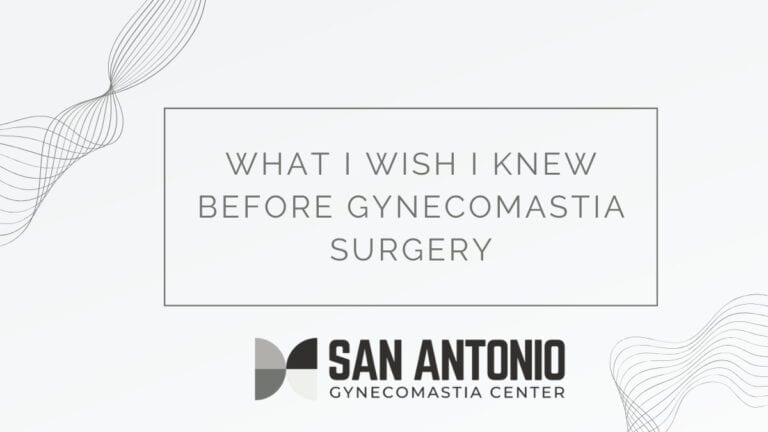At the San Antonio Gynecomastia Center, Dr. Michael Baumholtz has worked with many men seeking relief from a condition that often goes unspoken. Excess male breast tissue, also known as gynecomastia, can impact confidence, body image, and day-to-day life. While the procedure itself is straightforward and highly effective, every patient’s journey is unique.
We spoke with several individuals who underwent male breast reduction surgery with Dr. Baumholtz to gather the one piece of advice they believe made the biggest difference in their experience.
Below, these patients offer honest, firsthand insights about what helped them most before, during, and after gynecomastia surgery.
Jason, 26 – “Do not rush your recovery”
I had been living with gynecomastia since I was a teenager. I worked out five days a week and kept a healthy diet, but the excess chest tissue never went away. It affected what I wore and how I carried myself. I finally booked a consultation after years of trying to ignore it.
The procedure went smoothly, and the results were amazing. But if there’s one thing I would tell anyone thinking about this surgery, it’s this:
Take your recovery seriously. I made the mistake of going back to the gym two weeks after surgery, thinking I felt fine. My results didn’t suffer long term, but I definitely caused extra swelling that lasted longer than it should have.
Here’s what helped me stay on track:
- Follow the timeline: I stuck to the recovery plan that Dr. Baumholtz gave me and resisted the urge to push past it.
- Wear the compression vest: It was uncomfortable at times, but it helped shape my chest and reduce swelling.
- Choose walks over workouts: Walking helped me stay active without putting stress on my chest.
Listening to my body and not rushing made all the difference in healing well.
Andre, 32 – “Be honest during your consultation”
Before surgery, I thought I could just keep it vague and let the doctor decide what needed to be done. But during my consultation with Dr. Baumholtz, I realized that being clear about my goals and concerns was essential.
I was nervous to talk about how much this had impacted my confidence, especially in relationships. But opening up helped the staff understand exactly what I wanted out of surgery. It also helped them adjust the surgical approach to match what I was hoping for.
My tip is this:
- Speak up about your goals: If something about your chest makes you uncomfortable, say it out loud.
- Be honest about your lifestyle: This includes your workout habits, work schedule, and anything that could affect recovery.
- Ask direct questions: Knowing what to expect helped reduce anxiety before the procedure.
The more I shared, the better prepared I felt going into surgery.
Miguel, 41 – “Get your compression gear ready in advance”
I run a business and have a packed schedule. I knew taking time off would be tough, so I prepped everything a week before surgery. That included getting all my post-op supplies and especially ordering a second compression vest.
It may seem like a small thing, but having a backup vest made life so much easier. When one was in the wash, I could immediately switch to the other. Staying consistent with compression was key to my results.
For anyone getting ready for gynecomastia surgery, here’s what I suggest:
- Order two compression garments: It helps you stay compliant without gaps.
- Prep meals in advance: I stocked my fridge with simple, healthy meals so I wouldn’t have to cook during early recovery.
- Set up a rest area: I arranged pillows and ice packs where I could relax without straining myself.
Preparing ahead of time helped me avoid stress and stay focused on healing.
Leo, 23 – “Do not compare your recovery to others”
I joined a few online forums before my surgery and followed some recovery timelines. At first, I found them helpful. But once I hit week two, I started worrying that my swelling was worse or that my results weren’t coming along as fast.
Dr. Baumholtz reminded me that every body heals differently. That advice helped me stop stressing about what other people were posting and instead focus on what was happening with my own body.
My biggest advice is:
- Track your own progress: Take weekly photos so you can see changes over time.
- Avoid obsessing over internet timelines: Most of them are general and not based on your personal case.
- Ask your surgeon, not strangers: If something feels off, the only person who should evaluate it is your doctor.
Focusing on my own journey helped me stay calm and more confident through the recovery process.
What These Stories Have in Common
Each patient had a different tip, but some key patterns stood out in their advice. Here are the takeaways that came up most often:
- Recovery is not a race: Letting your body heal properly leads to better long term results.
- Communication is key: Open discussions with Dr. Baumholtz during consultation and follow-ups lead to personalized care.
- Preparation matters: Planning ahead makes recovery smoother and less stressful.
- Every recovery is unique: Stay focused on your body and not someone else’s timeline.
These lessons can make a big difference if you are considering gynecomastia surgery in the San Antonio area.
Ready to Take the Next Step?
Hearing from real patients helps demystify what gynecomastia surgery is truly like. At the San Antonio Gynecomastia Center, Dr. Michael Baumholtz works closely with each patient to develop a plan that fits both their body and their goals. Whether your concerns are cosmetic, functional, or emotional, you deserve to feel confident in your own skin.
If you are thinking about male breast reduction surgery, schedule a consultation to learn more about your options and what results are possible for you.



